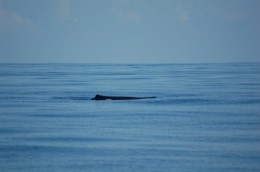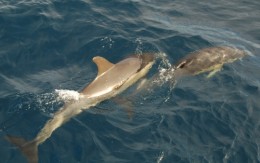South to the Canaries
This is page 2 of a 4 page article.
If you haven't read the earlier pages, please start from the beginning.
PART II – THE wildLIFE ON THE OCEAN WAVE
By the following morning the wind had risen to a force five, and we were bowling along over the deep blue sea with white capped waves rolling past on either side. Roxanne caught a glimpse of a something drifting by.
“It was round, but it had flippers like a dolphin!”
Undoubtedly a sunfish. I showed her a picture, in one of our guides, and she confirmed the ID.
We escaped from the Mediterranean that same night, dodging around the ships, slooshing through the narrow strait on the back of a force seven, and being swept out into the bright blue waters of the Atlantic.
“Allelujah!”
And not only were we out of the Med, at long last, we were also warm. The water temperature in the Atlantic was three degrees warmer than inside the land-locked pond, and the sun was shining down. By midday we were able to shed our oilskins, kick off our seaboots, unwind our scarves, and slip out of our thermal undies. (But we left in place those layers between the undies and the oilskins, because it certainly wasn’t hot enough yet for sun-bathing.)
The wind for the next leg of our journey might have been expected to be blowing from the north. The ocean winds generally circulate in a roughly predictable manner, and nine times out of ten the wind in this region would have been flowing down the African coast – but, naturally enough, when it saw us coming the wind doubled into the south-west, giving us a headwind.
We were not complaining. This is the third time that we have sailed south towards the Canaries at Christmas time. On the last occasion, when Caesar and Xoë were very small, we had a pleasant gale on the stern. The time before that we had a force ten on the beam. So long as we did not have to go through that sort of thing again we were happy.
We drifted merrily down the coast of Morocco, now heading out to sea, and then, on the next day, tacking back in again. To pre-empt the inevitable question – we didn’t motor because we hate motoring; besides being noisy and smelly, motoring is expensive, whereas the wind is free, and motoring is damaging to the environment. Our boat leaves no carbon footprint.
On the evening of the 22nd December the wind died altogether leaving us slatting about. I made bread; Nick fiddled with the running rigging, tweaking this and parcelling that; Caesar and Roxanne made fishing lures; Xoë buried her nose in her books and recited Cicero’s speeches to the starry sky. Poppy-Dog had spent the journey thus far sulking under the table in the aft cabin, but she now condescended to come on deck and play.
On the following day there was still no wind and the sea was a blue plain, as smooth as satin. Seemingly, it was a desert, devoid of any life – but when she looked more closely the ship’s naturalist began to find things. Dozens of tiny velella were drifting past, some of them smaller than my smallest finger nail. A little turtle, scarcely bigger than a dinner plate cavorted about just below the surface, looking like a green leaf tossed on the current.

“This is the weather for sighting whales,” I told Roxanne.
Xoë came on deck to shake out her dog’s blanket. “There’s one,” she said casually.
Not one, in fact, but three; three sperm whales were swimming about close by. There was one on either side of the boat, about a hundred yards disant, and there was another some way astern. We glimpsed their shiny black backs, saw their blunt heads momentarily, and caught brief glimpses of their stumpy fins and sometimes of their huge tails. Whale watching is always so frustrating. The drawings in the books show big, beautiful animals, but all we ever catch is a fleeting glance at one little part; less, even, than the tip of an iceberg. The rest of the whale we have to build, in our minds, from our knowledge of those pictures. No wonder the ancient mariners saw fabulous beasts!
There were fish jumping in the water nearby; hundreds of fish jumping en masse. No, not hundreds; thousands. A thousand silver slivers entering the air for a moment – and again – and again – so that the calm sea was scratched by a continual wave of fish. Who’d be a mackerel? Someone – or something – was in hot pursuit.
“I think that the whales are chasing those fish,” said Roxanne.
That was even more frustrating. To know that they were there – to see the evidence – but not to glimpse the leviathan.
“If you look down you might see a whale under the boat,” I said, speaking in jest.
We all looked down, instinctively – and there, swimming under our feet, was a whale! A huge, beautiful, mottled grey whale swimming casually along, fifty feet below us, from one side of our boat to the other!
A moment later one of the other whales came swimming towards us, at the surface, to investigate. I chose this moment to dive below to grab the camera, so missing the closest encounter, but Roxanne says that the great head came so close that she looked into the whale’s huge eye.
Perhaps it was our yells of delight which aroused the whales’ curiosity. What do they think when they see us, I wonder? Do they mistake Mollymawk for another kind of sea monster, or do they understand that our boat is not a living thing?
We once had a whale shark rubbing close alongside the hull – which tends to suggest that he was trying to make friends – but whales, like dolphins, are reputed to be far more intelligent than fish. What goes through their minds, I wonder? What do they know?
Possibly not so much as we would like to believe.
These particular cetaceans did not stay around and get to know us. Two slid away unseen, and the third waved his tail and was gone. I pictured them strolling about across the abyssal plain, two miles below our world.
The next day was Christmas Eve and our sightings included a hoopoe, which almost landed aboard. In fact, it almost landed on Roxanne’s head, but then it thought better of the idea and continued in the direction of Morocco. (Yes, a hoopoe. No, it’s not the sailor’s nickname for a seagull; I really do mean a hoopoe, with black and white butterfly wings, and a crest, and a splendid curved bill.)

Later in the day we received a visit from a huge school of common dolphins (Delphis delphinum). The girls reckoned that there were somewhere around two hundred of them, although we only ever had ten or twelve riding with us at any one time.
Again, I found myself wondering what these creatures thought of the boat and her crew. Some of them laid on their sides in the water, as this species are wont to do, seeming to gaze up at us. Others, as they rose to breathe, lifted an eye above the surface and looked at us for a moment.
But none of them stopped to stare. None of them did more than glance at us. Dolphins never do; they are not like us; they are not fascinated by the encounter or curious to know more.
We actually know quite a bit about the dolphin’s world, but they know absolutely nothing of ours. For them, cities, cars, books, and politicians do not exist. Indeed, they do not even know about trees, flowers, and bumble bees.
We meet at the surface of the dolphin’s world, they take a look – and then they move on.
What strange mentality is this, which is as big as ours and yet lacks our insatiable desire to learn more?
I can put myself into the mind of a dog or a cat, and imagine their thoughts. I can understand the mentality of an ape or an elephant; from the way they behave it seems clear that these other mammals share many of the emotions experienced by the human animal. But no matter how often I meet them and watch them I can never, ever understand cetaceans. Are they so happy, in a childlike way, that they need nothing more? Or are they so clever that their intelligence is beyond my comprehension?
Until they speak to us, we will probably never know.
